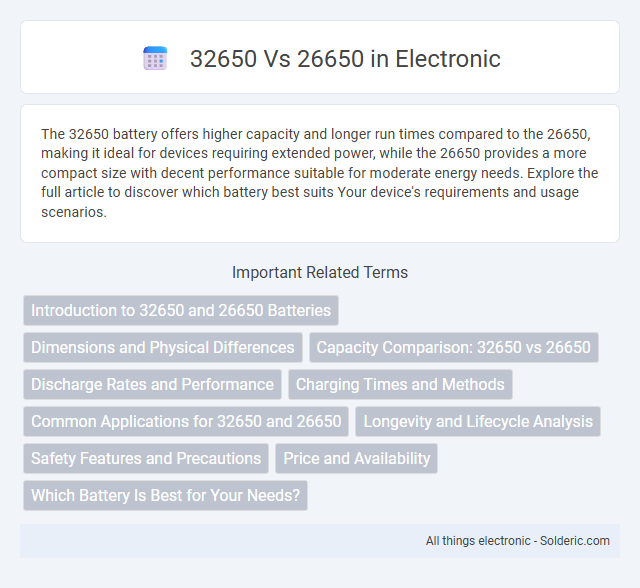The 32650 battery offers higher capacity and longer run times compared to the 26650, making it ideal for devices requiring extended power, while the 26650 provides a more compact size with decent performance suitable for moderate energy needs. Explore the full article to discover which battery best suits Your device's requirements and usage scenarios.
Comparison Table
| Feature | 32650 Battery | 26650 Battery |
|---|---|---|
| Dimensions | 32mm diameter x 65mm length | 26mm diameter x 65mm length |
| Capacity | Up to 6000mAh | Up to 5000mAh |
| Nominal Voltage | 3.2V - 3.7V (LiFePO4 / Li-ion) | 3.2V - 3.7V (LiFePO4 / Li-ion) |
| Maximum Discharge Current | Typically 15A - 20A | Typically 10A - 20A |
| Weight | Approx. 70-80g | Approx. 50-70g |
| Common Uses | High capacity flashlights, electric bikes, power tools | Flashlights, power tools, portable electronics |
| Price | Higher due to larger size and capacity | Generally more affordable |
Introduction to 32650 and 26650 Batteries
32650 and 26650 batteries are cylindrical rechargeable lithium-ion cells distinguished primarily by their dimensions and capacity. The 32650 battery measures 32mm in diameter and 65mm in length, often providing higher energy capacity ranging from 5000mAh to 7000mAh, suitable for high-drain devices and industrial applications. In contrast, the 26650 battery, with a 26mm diameter and 65mm length, typically offers capacities between 3500mAh and 5000mAh, making it popular for flashlights, power tools, and portable electronics requiring balanced size and power.
Dimensions and Physical Differences
The 32650 and 26650 lithium-ion batteries differ significantly in dimensions, with the 32650 measuring approximately 32mm in diameter and 65mm in length, while the 26650 is around 26mm in diameter and 65mm long. These size differences impact the battery capacity and compatibility with devices, as the larger 32650 offers higher capacity but may not fit into devices designed for the smaller 26650. Understanding these physical distinctions helps ensure your device operates efficiently and safely with the appropriate battery size.
Capacity Comparison: 32650 vs 26650
The 32650 battery typically offers a capacity range of 5000mAh to 6000mAh, surpassing the 26650's usual 3500mAh to 4200mAh capacity, making it ideal for devices requiring longer runtimes. Its larger size allows for increased energy storage, providing extended usage periods without frequent recharging. When optimizing your device's battery life, choosing a 32650 over a 26650 can significantly enhance performance due to this capacity advantage.
Discharge Rates and Performance
The 26650 battery generally offers higher continuous discharge rates, often up to 30A, making it suitable for high-drain devices, whereas the 32650 typically supports lower discharge rates around 10-15A but provides greater capacity. Performance-wise, the 32650 excels in energy storage with capacities ranging from 5000mAh to 6600mAh, delivering longer runtimes for equipment requiring sustained power. The 26650's combination of moderate capacity (3000mAh to 4200mAh) and higher discharge rates makes it ideal for applications demanding bursts of power and rapid energy delivery.
Charging Times and Methods
The 32650 battery typically supports faster charging times due to its larger capacity and compatibility with high-current chargers, often requiring around 3 to 4 hours for a full charge. In contrast, the 26650 battery usually has a smaller capacity, leading to shorter charging durations, generally about 2 to 3 hours when using standard chargers. Both battery types commonly utilize Lithium-ion charging methods with constant current/constant voltage (CC/CV) protocols to ensure safe and efficient charging cycles.
Common Applications for 32650 and 26650
The 32650 and 26650 lithium-ion batteries are commonly used in high-drain devices such as electric vehicles, power tools, and portable energy storage systems. The 32650 battery, with a larger capacity and longer runtime, is favored in applications requiring extended use and higher power output, like electric bikes and solar power backups. Your choice between these batteries depends on the required energy density and device size, with 26650 cells often preferred for compact flashlights and smaller electronics due to their balance of capacity and size.
Longevity and Lifecycle Analysis
The 32650 battery typically offers a longer lifespan compared to the 26650 due to its larger capacity and enhanced thermal stability, supporting more charge-discharge cycles before significant capacity loss occurs. You can expect the 32650's lifecycle to range between 800 to 1200 cycles, whereas the 26650 usually endures around 500 to 800 cycles under similar usage conditions. Longevity in real-world applications depends on factors like discharge rates, temperature, and maintenance, making the 32650 a preferable choice for devices requiring extended battery performance.
Safety Features and Precautions
The 32650 battery offers enhanced safety features such as built-in overcharge protection and higher thermal stability compared to the 26650, reducing the risk of overheating and potential hazards. 26650 cells require careful handling and external protection circuits to prevent over-discharge, short circuits, and thermal runaway. Proper usage guidelines for both battery types include avoiding physical damage, maintaining optimal charging rates, and storing batteries in a cool, dry place to ensure maximum safety and longevity.
Price and Availability
The 32650 batteries typically cost more than the 26650 due to their larger size and higher capacity, often leading to limited availability compared to the more common 26650 cells. You can find 26650 batteries widely available at competitive prices from various retailers, making them a cost-effective option for many applications. When considering price and availability, 26650 batteries generally offer better accessibility and affordability for everyday use.
Which Battery Is Best for Your Needs?
The 32650 battery offers higher capacity and longer runtime, making it ideal for devices that require extended power, such as high-drain flashlights and portable power banks. In contrast, the 26650 battery provides a more compact size with a balance between capacity and portability, suitable for applications where space is limited but reliable power is still needed. Assess your device's size constraints and power consumption to determine whether the 32650's extended endurance or the 26650's convenient form factor best suits your needs.
32650 vs 26650 Infographic

 solderic.com
solderic.com